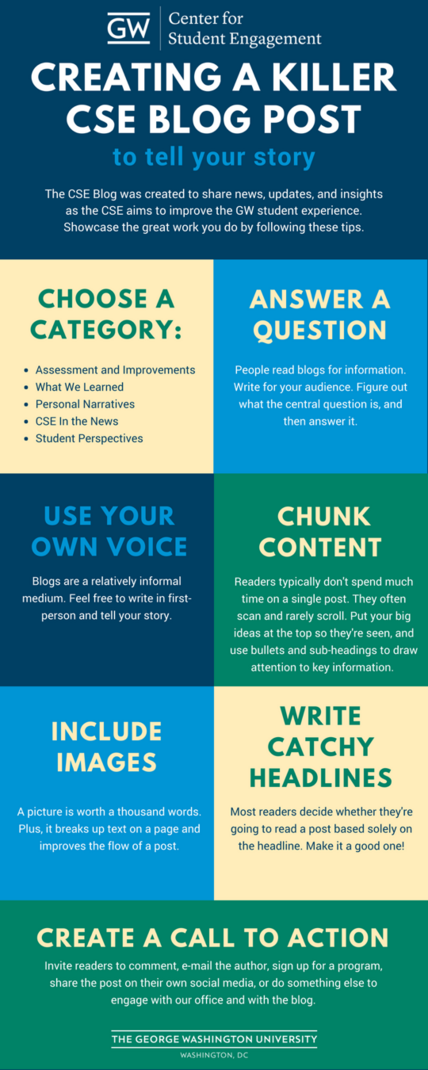In the field of student affairs, we know assessment and data-based decision-making are important. A key step in the assessment cycle is reporting: sharing results and decisions with stakeholders. In the Center for Student Engagement (CSE) at George Washington University, we set out to improve how we report assessments results and tell our story - and so the CSE Blog, entitled You’ve Been Engaged, was founded.
The purpose of the CSE Blog is to tell our story, promote the good work that we do, and share the professional development in which we engage. Since September 2017, we’ve published 26 blog posts, and we’ve had 1,204 unique pageviews by 559 users, as reported by Google Analytics. The posts cover a variety of topics: from reflections on conferences like NASPA and ACPA to changes in resident advisor selection and student elections. Our most-read post is a poignant account of how one staff member manages her learning disability in her professional work.
In our blog posts, we use several strategies for communicating to stakeholders in a way that is digestible and engaging:
-
Infographics (usually created on Canva or Piktochart) convey information - particularly assessment results - in a visual way, and accompanying text provides additional context and explanation.
-
Casual language promotes readability and sustained interest.
-
Reflections on professional development experiences encourage staff to critically engage with what they learned, share learning with others, and further justify the funds spent.
-
Stories about our big projects are accompanied with pictures to enhance the reader’s experience and understanding.
-
Sharing innovative ideas not only promotes our work, but also allows other institutions to consider adopting new practices in their own work.
From our first year, we learned six tips for launching a blog:
-
Post regularly. During the first year, we published posts as they were written: sporadically. However, blogs are more likely to get return readers with consistent posts, and thus we are now focusing on posting once a week on the same day each week.
-
Schedule posts in advance. During the first year, we had trouble generating buy-in, and therefore content, from fellow staff members. The blog was not a priority in their work, so blog posts were often not written in a timely manner. Once we started scheduling posts, staff had a deadline for writing, which led to more content - and to more regular posts.
-
Plan posts intentionally with an editorial content calendar. To help with posting regularly and ensure we are posting the right content at the right times, we aim to use the summer to plan out posts for the year so we can be prepared and on-time. For example, we have plans to do a spotlight series on the career paths of our staff during Careers in Student Affairs Month in October.
-
Provide clear guidelines for authors. We created an infographic, shown below, to communicate our expectations and blogging best practices for authors.
-
Promote blog posts in relevant communities. Our first posts didn’t get much traffic, but we focused on promoting posts to potential readers based on interest. For example, our most-read posts include one about first-generation students that was shared within the NASPA Center for First-Generation Student Success, and another about a staff member’s professional involvement helping combat imposter syndrome that was shared among the NASPA Pan-African Network. We also started using relevant hashtags to increase our social media reach, such as #SAPros, #ACPA, #studentelections, and more. More than 50% of our traffic comes from social media, especially Facebook and Twitter, which each account for 35% of our referral traffic.
-
Share Google Analytics data with staff. To increase buy-in, we need to demonstrate the effectiveness of what we’re already doing. Sharing the analytics has communicated to authors that the CSE Blog is having an impact, which encourages them to write additional articles. Plus, it reinforces the message of the blog; share assessment results with stakeholders.

Our ultimate goal is for an author to get a comment, call, or e-mail from a person at another institution who read their post and wants to learn more. If something we wrote intrigues you, let us know! In the meantime, we will continue to promote our own work and tell our story.
Kaitlyn Schmitt, George Mason University
**Kaitlyn began her new role as Assistant Director for Student Involvement at George Mason University on July 2, 2018. Prior to that, Kaitlyn served as the Program Coordinator for Student Involvement at George Washington University, about which this blog post was written.
